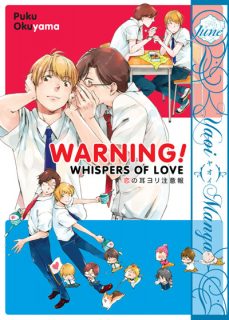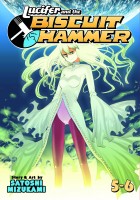My News and Reviews
Last week at Experiments in Manga the winner of the Kuroko’s Basketball giveaway was announced. The post also includes a list of some of the tournament and competition manga that has been licensed in English. As per usual these days, there wasn’t much else from me, but there is some other very exciting Manga Bookshelf news: The Manga Critic is back! Be on the lookout for some great content from Kate Dacey. Last week I also read Makoto Yukimura’s eighth Vinland Saga omnibus which was, as expected, excellent. (I highly recommend the series as a whole.) However, you won’t find a quick take of it below because I’m going to try to write up a full-length review of it instead. We’ll see how it goes!
Elsewhere online, The OASG has started a new series called How Fans Can Help the Anime & Manga Industries Grow in which industry folk share their experiences an thoughts on the subject. So far, the responses from Charlene Ingram, Viz Media’s senior manager of marketing, and Charis Messier, lead translator at Cross Infinite World, have been shared. Another interesting read courtesy of Sakuga Blog is a translation of a roundtable with three manga editors (Tatsuya Kusunoki, Katsuyuki Sasaki, and Ryouji Takamatsu) discussing the growth of the yuri genre. As for boys’ love, Khursten at Otaku Champloo takes a closer look at the Dangerous BL Manga list for 2017.
Quick Takes
 Firefighter! Daigo of Fire Company M, Volumes 2-10 by Masahito Soda. I enjoyed the first volume of Firefighter! well enough to seek out the rest of the manga (while the entire series is now available digitally, most of the individual volumes are well out-of-print) and I am so incredibly glad that I did. I’m only halfway through, but Firefighter! is fantastic. It has exciting action, compelling drama, and engaging characters. The titular Daigo is a rookie firefighter who, although he seems to have good instincts, has a lot to learn. Each rescue he’s a part of is more audacious than the last and he frequently ends up in the hospital as a result. Daigo hasn’t lost anyone yet, but his unorthodox ways, disregard for direct orders, and tendency to go overboard puts his own life and the lives of other rescue workers at risk. It seems like it’s only a matter of time before tragedy will strike, but no one can deny that he has saved people who would have otherwise died. Firefighter! is intense and thrilling, but it actually has a fair amount of humor as well. (For all his bravery, Daigo is kind of a goofball.) I’m definitely looking forward to reading the series’ second half.
Firefighter! Daigo of Fire Company M, Volumes 2-10 by Masahito Soda. I enjoyed the first volume of Firefighter! well enough to seek out the rest of the manga (while the entire series is now available digitally, most of the individual volumes are well out-of-print) and I am so incredibly glad that I did. I’m only halfway through, but Firefighter! is fantastic. It has exciting action, compelling drama, and engaging characters. The titular Daigo is a rookie firefighter who, although he seems to have good instincts, has a lot to learn. Each rescue he’s a part of is more audacious than the last and he frequently ends up in the hospital as a result. Daigo hasn’t lost anyone yet, but his unorthodox ways, disregard for direct orders, and tendency to go overboard puts his own life and the lives of other rescue workers at risk. It seems like it’s only a matter of time before tragedy will strike, but no one can deny that he has saved people who would have otherwise died. Firefighter! is intense and thrilling, but it actually has a fair amount of humor as well. (For all his bravery, Daigo is kind of a goofball.) I’m definitely looking forward to reading the series’ second half.
 Horimiya, Volumes 2-4 written by Hero, illustrated by Daisuke Hagiwara. While I wasn’t quite as taken with these few volumes as I was with the first, I am still enjoying Horimiya a great deal. After accidentally discovering each other’s secrets, Miyamura and Hori have developed a close friendship which is slowly evolving into something more. It takes some time, but eventually they’re able to recognize their feelings and actually act on them. In large part, Horimiya is a manga about relationships of all types. Friendship and family are just as important, and are sometimes even more important, than the series’ romance. It’s also a manga which excels in depicting the characters’ multifaceted natures, showing how they behave differently depending on who is present. As more characters are introduced (including Hori’s father and some of Miyamura’s friends from middle school), the social dynamics in the series naturally change. Horimiya isn’t a manga that has me on edge desperate to know what will happen next, but the characters are tremendously endearing and I do want to see things work out for all of them.
Horimiya, Volumes 2-4 written by Hero, illustrated by Daisuke Hagiwara. While I wasn’t quite as taken with these few volumes as I was with the first, I am still enjoying Horimiya a great deal. After accidentally discovering each other’s secrets, Miyamura and Hori have developed a close friendship which is slowly evolving into something more. It takes some time, but eventually they’re able to recognize their feelings and actually act on them. In large part, Horimiya is a manga about relationships of all types. Friendship and family are just as important, and are sometimes even more important, than the series’ romance. It’s also a manga which excels in depicting the characters’ multifaceted natures, showing how they behave differently depending on who is present. As more characters are introduced (including Hori’s father and some of Miyamura’s friends from middle school), the social dynamics in the series naturally change. Horimiya isn’t a manga that has me on edge desperate to know what will happen next, but the characters are tremendously endearing and I do want to see things work out for all of them.
 Warning! Whispers of Love by Puku Okuyama. So far, only two of Okuyama’s boys’ love manga have been released in print. I had previously read and wasn’t overly impressed by the more recent Caramel despite liking some of the manga’s individual elements (in fact, overall I can’t really say that I enjoyed it much) but I already had a copy of Warning! so I figured I should at least give it a try. I’m happy to say that I enjoyed Warning! much more than I did Caramel. It’s a collection of rather silly boys’ love stories ranging from the subtly amusing to the overtly goofy. They tend to be fairly cute as well and generally any physical intimacy that is shown is limited to a few kisses and chaste embraces. Most of Warning! is devoted to the story of Hajime, a first year at an all-boys school, and the incredibly awkward relationship that develops between him and an upperclassman who seems to want nothing more than to clean the wax from Hajime’s ears. It’s easily the most ridiculous setup in the entire volume but it can be legitimately funny–all the boys’ love tropes and jokes that would typically be applied to sex are applied to ear cleaning instead and it’s surprisingly effective.
Warning! Whispers of Love by Puku Okuyama. So far, only two of Okuyama’s boys’ love manga have been released in print. I had previously read and wasn’t overly impressed by the more recent Caramel despite liking some of the manga’s individual elements (in fact, overall I can’t really say that I enjoyed it much) but I already had a copy of Warning! so I figured I should at least give it a try. I’m happy to say that I enjoyed Warning! much more than I did Caramel. It’s a collection of rather silly boys’ love stories ranging from the subtly amusing to the overtly goofy. They tend to be fairly cute as well and generally any physical intimacy that is shown is limited to a few kisses and chaste embraces. Most of Warning! is devoted to the story of Hajime, a first year at an all-boys school, and the incredibly awkward relationship that develops between him and an upperclassman who seems to want nothing more than to clean the wax from Hajime’s ears. It’s easily the most ridiculous setup in the entire volume but it can be legitimately funny–all the boys’ love tropes and jokes that would typically be applied to sex are applied to ear cleaning instead and it’s surprisingly effective.
 Wandering Son directed by Ei Aoki. Takako Shimura’s manga Wandering Son is an incredibly important series to me personally, so I was greatly saddened when Fantagraphics stopped releasing it in English. Initially I wanted to read the entire manga before watching the anime adaptation but, seeing as the rest likely won’t be available any time soon, I finally gave in. The Wandering Son anime is a lovely series. It’s not an exact adaptation of the manga, but it is faithful to the original story and characters. In general, the narrative style of the anime tends to be a little more linear than that of the manga. However, both series provide an empathetic exploration of gender identity, following a group of middle school students who are learning who they are. It’s a fairly realistic portrayal, meaning that society isn’t always the most accepting which can be absolutely heartbreaking. However, seeing the characters become more confident in their selves even when that goes against what is expected of them is exceptionally validating. The anime only adapts a portion of the manga and doesn’t provide much of a resolution (though it does go beyond where Fantagraphics left off), but it is still very well done and well-worth watching.
Wandering Son directed by Ei Aoki. Takako Shimura’s manga Wandering Son is an incredibly important series to me personally, so I was greatly saddened when Fantagraphics stopped releasing it in English. Initially I wanted to read the entire manga before watching the anime adaptation but, seeing as the rest likely won’t be available any time soon, I finally gave in. The Wandering Son anime is a lovely series. It’s not an exact adaptation of the manga, but it is faithful to the original story and characters. In general, the narrative style of the anime tends to be a little more linear than that of the manga. However, both series provide an empathetic exploration of gender identity, following a group of middle school students who are learning who they are. It’s a fairly realistic portrayal, meaning that society isn’t always the most accepting which can be absolutely heartbreaking. However, seeing the characters become more confident in their selves even when that goes against what is expected of them is exceptionally validating. The anime only adapts a portion of the manga and doesn’t provide much of a resolution (though it does go beyond where Fantagraphics left off), but it is still very well done and well-worth watching.



